| |
The
Straits Times, 7 Apr 05
The heron rises from the ashes
by Chua Mui Hoong
From the moment we stepped off the ferry onto the jetty of Pulau Semakau,
we were entering a different world. The water cerulean blue, the colour
of the sky on a moonlit night. Clinging to jetty steps were clumps of sea
fans, pink branches dancing about a foot underwater. Oysters clamped onto
the steps like barnacles.
Pulau Semakau is a landfill. But unlike most rubbish dumps, it is also a
pristine island full of wildlife. In a bold innovation, the Ministry of
the Environment and Water Resources is opening it up to nature groups from
July.
Nature haven in a dump? The Straits Times asked for a preview and was not
disappointed. Ten of us took the 15-minute ride from Pasir Panjang Ferry
Terminal to Pulau Semakau: bird and shore-life enthusiasts, National Environment
Agency (NEA) staff, photographer Chew Seng Kim and myself.
In a van headed for the mangroves on the island's north-west, we saw a flutter
of wings from a large bird. "Great-billed heron," said Nature
Society member and bird expert Lim Kim Seng. This heron, named for its large
bill, stands about 110cm from its bill to the tip of its tail. Its wing
span is over 2m. According to Mr Lim, it lives in mudflats and coral reef
flats throughout Asia but is hard to spot. It is not common on the main
island of Singapore, and malaysia. "It seems more confined to the southern
islands".
There would be eight
sightings of this beautiful bird with its dusky grey plumage and blackish
legs that morning: in flight, wading by the waters, looking out to sea,
its large curved bill framed like a big question mark against the horizon.
In the three hours, Dr Ho Hua Chew, the Nature Society's conservation committee
chairman and Mr Lim counted 28 species identifying them in mid-flight from
their flight patterns and silhouettes, or by their calls. They spot the
brahminy kite, circling above the reef flats, the oriental honey buzzard,
a migrant to Singapore's shores, the mangrove whistler, tailorbird, magpie
robin and others. "Lots of potential from a bird-watching point of
view", says a pleased Dr. Ho.
The
350ha Pulau Semakau is home to Singapore's rubbish that cannot be
incinerated, such as construction and renovation debris and ash from
incineration plants. Its landfill can hold 63 million cubic metres
of rubbish, enough for Singapore's waste until around 2040.
But the dump takes up only one part of the island. There is a patch
of mangrove forest on the north-western tip, with a reef shore. The
air is pungent, not with the stench of rubbish, but the salty, fishy
tang of the sea.
To prepare the island for visitors, simple amenities will be put up
-- informational signs, simple shelters to protect from lightning
storms -- but no cafes and no toilets outside the main NEA building
at the jetty. General Manager of the Semakau landfill Vincent Teo
says the island will be open by July to groups that want to organise
tours. But those who come should know that the wildlife won't be on
display as in a zoo, and can be spotted only with patience and keen
observation.
Already, birdwatches from the Nature Society, anglers from the Sport
Fishing Association, and the Wild Singapore group of marine enthusiasts,
have voiced interest in activities there.
The idea to turn a rubbish dump into a nature area was seeded three
years ago by NEA chairman Simon Tay when he visited the island. Eventually,
a working group was formed. The NEA consulted different groups, tapping
their enthusiasm and expertise.
Ms Ria Tan, for example, and a group of volunteers are helping to
survey the shore life. They need to know the terrain better, to chart
a route for future guided tours of the mudflats. The shore area is
off-limits till 2007 for this work to be carried out.
Surprisingly for an area so close to urban Singapore, there rich biodiversity
in the waters. Close to the shore, we wade through mudflats. Someone
spots a pair of common starfish mating. A hairy crab, palm-sized,
perfectly camouflaged against the rocks, scurries by. I spot a snail
with a grey shell and speckled body, which I am told is a noble volute.
It burrows in the sand and eats other snails.
As we head out towards the sea, the vegetation and wildlife becomes
perceptibly different. Soon we are ankle deep in water, amid a bed
of tape seagrass. It looks like broad green mee pok noodles. There's
a graceful swirl of speckled brown, a flatworm. Unlike cylindrical
worms, this one is flat and about the length and width of two fingers.
When it moves, its purple fringe twirls like the skirt of a flamenco
dancer.
Where the water reaches our shins, we see mounds of coral: pink, brown,
beige, blue, white, speckled, dotted, cell-shaped. There is the baguette-shaped
mushroom coral. The distinct white tip and pink fronds of a sunflower
mushroom coral, and brain coral, so named because it looks like one.
There's a lovely dusky pink soft coral that drapes like a mound of
pancakes around rocks.
A map Ms Tan has produced of
marine life of the shores of the southern islands names it an
"omelette" coral. An executive with an information technology
company by day, a passionate nature activist at other times, she is
a seasoned volunter who trains and organises visits to shorelines
at low tides, the best time to go. On surveying Singapore's shores,
she says: "One lifetime is not enough to do this. You need a
whole anry to do it properly".
She is concerned about water quality off the southern islands and
its impact on wildlife. But she gives due credit to the NEA for having
kept pollution to a minimum at Pulau Semakau.
Take those sea fans at the jetty steps. They are branching animal,
sensitive to water quality. Their abundance so close to the landfill
suggests the water remains very clean. "It's a good sign",
she says.
Can a rubbish dump be turned into a nature area? She thinks for a
moment, "Well, we're doing it here". |
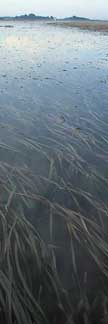
Tape seagrass lagoon
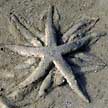
Mating common
sea stars
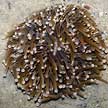
Sunflower mushroom coral
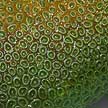
Hard coral
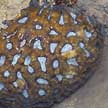
Hard coral
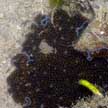
Flatworms
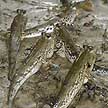
Mudskippers |
links
Photos of Semakau shores
during the Beachfleas visits.
Related articles on wild shores of Singapore
|

